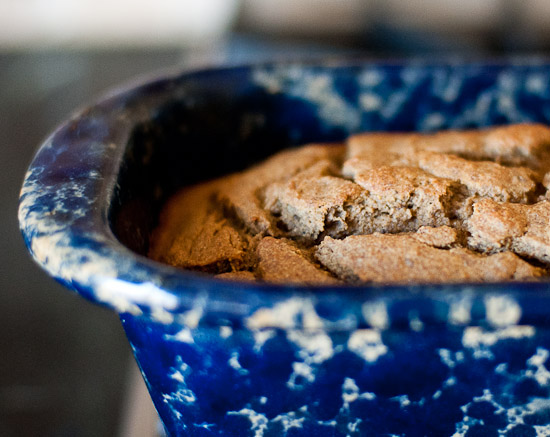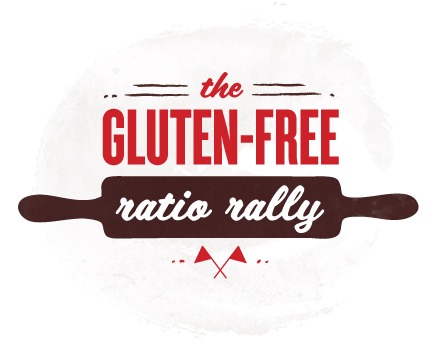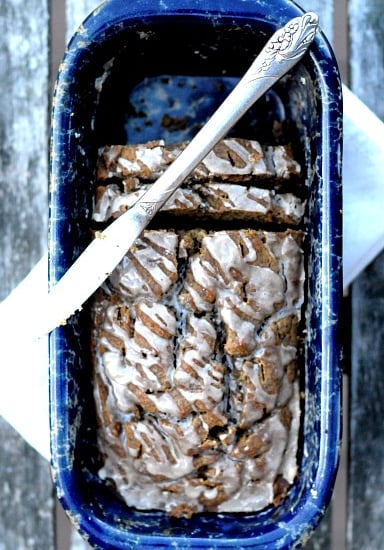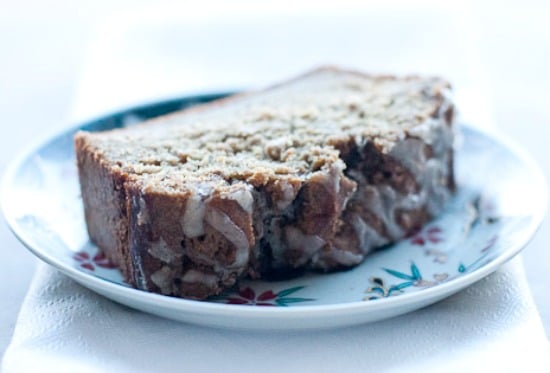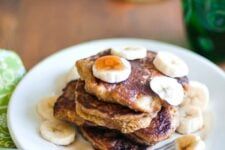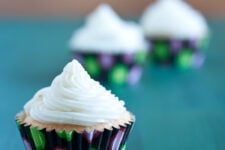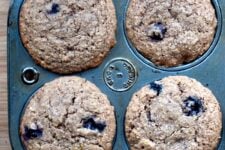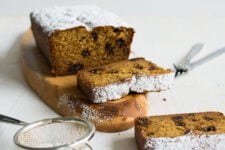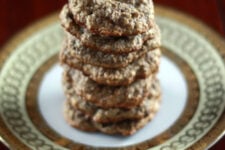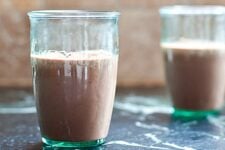4/29/11: A couple of people have had problems with the baking time for this banana bread. I’m going to need to do some re-testing, so please hold off on making it until I know the recipe is correct. XO Winnie
Even though I don’t have celiac disease, I choose to eat gluten-free. Why? Because I have a history of severe food sensitivities. I went for years without being able to eat wheat and other grains, so even though I can tolerate these foods in small amounts now, I am just used to not eating them. Plus, I feel better when I avoid gluten.
I eat a varied diet composed mostly of foods that are naturally gluten-free, and it’s recipes that contain these foods that are most prominently featured on this blog. If you’ve been reading for a while, you know I don’t post baked goods all that much: yes, you will find the occasional goodie that I successfully adapted to be gluten-free, but I honestly, I don’t think of myself as much of a baker. I’ve always felt that I lack the patience and skill required for developing truly great gluten-free baked goods. I figured it was way too time-consuming a process…something that required countless hours of recipe testing…something that’s best left up to folks like Amy, Karina, Jeanne, and Shauna.
Now let’s talk about Shauna for a second. I’ve been reading her blog for years. I love her writing and her recipes, but when she started baking only by weight recently, I was honestly a little miffed. I held out. I clung to my measuring cups. But then I read this and I started to come around. I have a scale…why not use it? So I started to weigh my ingredients. And I am now a convert. Using a scale means better gluten-free baked goods. It’s that simple. Or is it?
Welcome to the Ratio Rally: a monthly blogging event conceptualized by Shauna to get us comfortable and confident baking gluten-free by using ratios. What are ratios? Ratios are proportions of one ingredient to another. We’re using the indispensible Ratio: The Simple Codes Behind the Craft of Everyday Cooking as our guide…quoting Shauna:
“Each baked good has a ratio of fats to flours to liquid to eggs. Or other ingredients. What makes a muffin different than pizza dough? What makes bread different than a cake? It’s not just the ingredients. It’s the way those ingredients work in proportion to each other….This is why baking has to be by weight. Because a cup of white rice flour is not the same as a cup of whole wheat flour. They have radically different weights. Add 50 extra grams of flour to a cookie recipe and you have messed up the ratio.”
Last month, the inaugural ratio rally group tackled pancakes. This month, an even larger group baked quick breads.
We’re all posting our own spin on quick breads this month and Silvana is our host.
We each developed our quick bread recipe using the following ratio/starting point:
2 parts flour/2 parts liquid/1 part egg/1 part butter (or other fat)
1 large egg weighs approximately 2 ounces, so 2 eggs weighs 4 ounces. Therefore, if you wanted to make a batch of muffins or an average size quick bread, you would need:
8 ounces gf flours
8 ounces milk or other liquid
2 eggs (remember this equals 4 ounces)
4 ounces butter or other fat
So there you have it. Your quick bread ratio. Now all you have to do is add other ingredients to your liking!
My family loves classic banana bread, but when I tried to make it gluten-free in the past, it was, um, not very good. What do I mean by that exactly? I mean that my kids took one bite, immediately identified it as gluten-free and strange tasting, and decided to pass. So my goal here was to create a great banana bread, one that no one would necessarily know was gluten-free.
Using the above ratio and following Ruhlman’s banana bread recommendations on page 72 of Ratio, I reduced the liquid to 6 ounces total and browned the butter. I used buttermilk for the liquid because I had some I wanted to use up, but you could use regular milk or a milk substitute like rice or almond milk if you don’t do dairy. Don’t like to bake with butter? Try melted organic coconut oil or whatever oil you enjoy in your baked goods. I added a splash of vanilla extract and some cinnamon to the batter, but I think cardamom or ground ginger might be nice, too.
You probably noticed that sugar isn’t part of the ratio; this means the amount you use is really up to you. A savory quick bread wouldn’t need much, if any, but banana bread should be sweet. I used 1/2 cup of organic sugar in my recipe, and I think it’s perfect. I don’t like my food to be very sweet, though, so you might want to use 3/4 cup if you do. Another option would be to use honey or pure maple syrup: if you go the liquid sweetener route, you should reduce the milk or other liquid accordingly.
I was really pleased with my banana bread and I am I so glad that I now have an understanding of how this whole ratio business works. And boy, does it work. How do I know? Not because I made the recipe once. Or even twice. I know this ratio works because I made gluten free banana bread three times, using different gluten free flours each time. When baking gluten-free, I like to stick with the flours that are more nutrient dense. I like almond flour, teff flour, etc., and I like to stay away from the binders/gums whenever possible. You are welcome to use the flours that you are comfortable with, though. If you are not gluten-free, you may absolutely use 8 oz. of gluten-full flour here. As long as you stick to the the ratio, you are good to go.
[cft format=0]
Make sure to check out Silvana’s April Ratio Rally Post to see the other quick breads made by fellow ratio rally bloggers!
Recipe for Gluten Free Banana Bread
Ingredients
- *3 oz. brown rice flour or teff flour
- *3 oz. almond flour
- *1.25 oz. quinoa or sorghum flour
- *.75 oz. ground flax meal
- *1/2-3/4 cup organic sugar
- *1 teaspoon baking powder
- *1 teaspoon ground cinnamon or cardamom
- *3-4 large very ripe bananas
- *2 eggs preferably organic and free-range
- *1/2-3/4 cup buttermilk use the smaller amount if using 4 bananas
- *1/2 cup organic salted butter browned in a cast-iron skillet over low heat for 5-7 minutes (make sure you don't burn it) and allowed to cool
- *1 teaspoon all-natural vanilla extract
- *3/4 cup gluten-free chocolate chips- optional or glaze made from 6 tablespoons organic powdered sugar, 2 teaspoons water, and a pinch of ground cinnamon or cardamom)- optional
Instructions
- 1. Preheat the oven to 350 degrees F. and butter/oil a standard loaf pan.
- 2. In a large bowl, whisk the flours with the sugar, the baking powder, and the cinnamon.
- 3. In a blender, process the bananas with the eggs, the buttermilk, the cooled brown butter and the vanilla.
- 4. Pour the banana mixture into the flour mixture and combine with a rubber spatula. Fold in the chocolate chips, if using, then transfer batter to your prepared pan.
- 5. Bake for 55-60 minutes, or until a toothpick inserted in the center of the banana bread comes out clean.
- 6. If you are going to glaze the bread, mix the powdered sugar, water, and optional cinnamon together with a fork until the desired consistency is reached. Add a bit of water if you want it thinner, or more powdered sugar if you'd like it to be thicker. Set aside and wait to pour it on until the bread has cooled if you want the glaze to set (like in the pictures here); if you want it to seep in, you can glaze the bread while it's hot.
- 7. Glazed or not, allow some time for the bread to cool before slicing, if possible.

